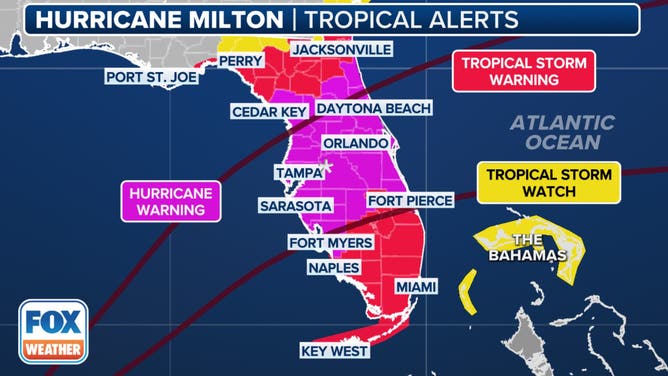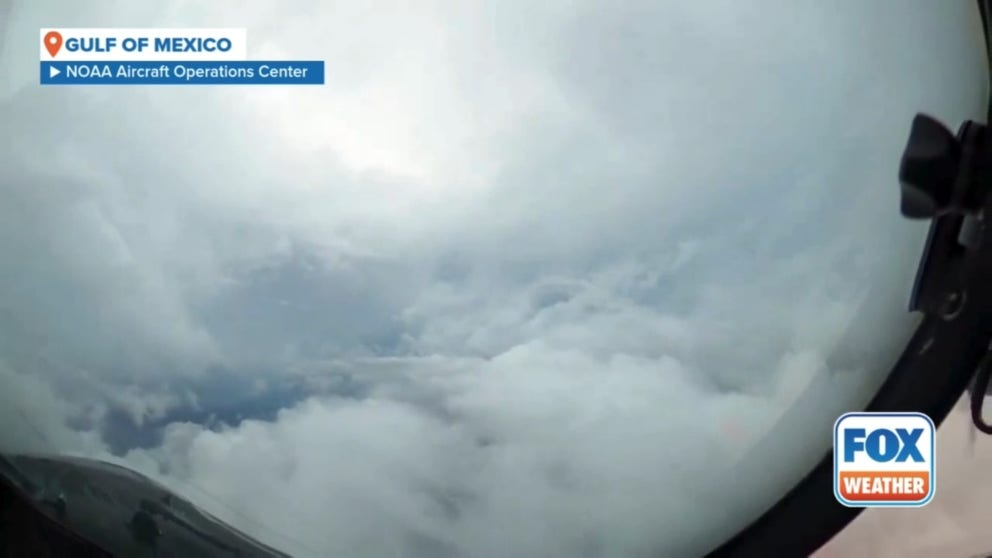Milton forces NOAA’s Hurricane Hunters to find a new temporary home
A NOAA spokesperson told FOX Weather it is planning to re-position two WP-3D Orions and one Gulfstream IV-SP aircraft from their home base in Lakeland, Florida, to an airport facility that is not directly in Milton’s cone of concern.
Take a wild ride inside Category 5 Hurricane Milton with Hurricane Hunters
Hurricane Hunters investigate Milton while it was strengthening over the Gulf of Mexico.
LAKELAND, Fla. – Even though NOAA’s Hurricane Hunters fly through cyclones on a routine basis, the threat of hurricane conditions at their home base in Central Florida has caused operations to be adjusted to avoid any damage to the agency’s aircraft.
A NOAA spokesperson told FOX Weather it is planning to re-position two WP-3D Orions and one Gulfstream IV-SP aircraft from their home base in Lakeland, Florida, to an airport facility that is not directly in Milton’s cone of concern.
All three aircraft have been used to investigate Milton and have even witnessed hail, lightning and birds while flying through the core of the once Category 5 hurricane.
Data collected from the planes and dropsondes is imported into computer forecast systems in order to more accurately depict future movements and swings in intensity.
In addition to the planes devoted to investigating Milton, six other aircraft have either been redeployed or are on missions away from the home base, which is about 30 miles east of Tampa.
At least one plane undergoing maintenance at the Lakeland facility will not fly out ahead of the storm, and staff will do the best job they can to secure the flying laboratory ahead of the elements.

Map indicates location of Lakeland, Florida airport
NOAA ORDERS NEXT GENERATION OF HURRICANE HUNTER AIRCRAFT
The temporary ceasing of operations at the Lakeland Linder International Airport is rather rare, as the Central Florida location doesn’t find itself in the center of many cones.
Hurricanes Helene, Debby and Idalia passed far enough away from the airport facility that impacts were considered to be relatively minor.
It is common practice by government agencies to evacuate high-priced equipment ahead of significant impacts from storm systems.
MacDill Air Force Base in Tampa moved most of its aircraft out of the way as of Tuesday and three guided-missile destroyers were deployed from Jacksonville’s Naval Station Mayport to avoid the rough seas.
All facilities are either in or near the forecast cone, making the bases susceptible to heavy rainfall, damaging winds, tornadoes and storm surge.

NOAA Hurricane Hunter aircraft
(NOAA)
WATCH: GO INSIDE MILTON’S CHAIR WITH FRONT-ROW SEAT ASIDE HURRICANE HUNTERS
In addition to NOAA’s aircraft, the Air Force’s 53rd Weather Reconnaissance Squadron has 20 crews based at Keesler Air Force Base in Biloxi, Mississippi, to investigate weather systems.
Mississippi is not in Milton’s forecast cone, so operations are expected to continue as normal at the facility.
The squadron uses the infamous Lockheed WC-130 Hercules aircraft to investigate hurricanes and other cyclones in the Atlantic Ocean, Caribbean Sea, Gulf of Mexico and central Pacific Ocean.
Flights into and out of Milton are expected to continue through Thursday morning up until landfall along Florida’s west coast and could resume again once the cyclone exists Florida’s east coast.
NOAA recently announced it has ordered two advanced hurricane hunter aircraft that are expected to enter service by 2030 and replace the aging WP-3D Orions.
Watch: Fly straight into raging Milton alongside NOAA's Hurricane Hunters
Go inside the flight station aboard NOAA’s WP-3D Orion 'Miss Piggy' as they fly straight into Hurricane Milton in the Gulf of Mexico.

